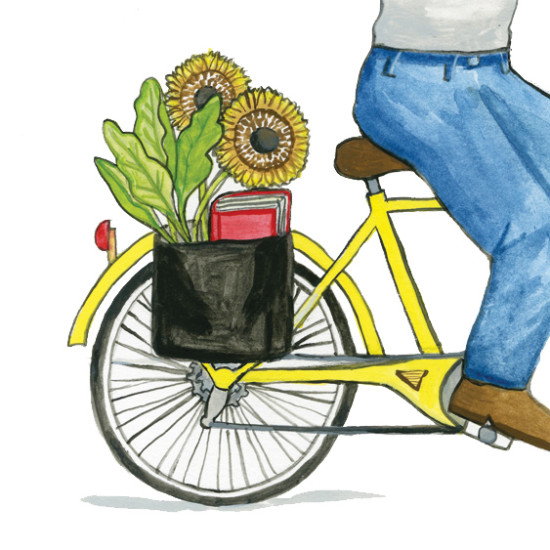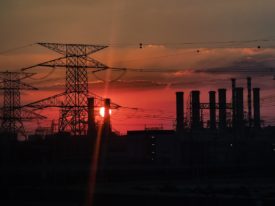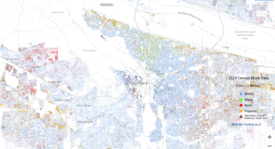Editor’s note: Sightline is excited to feature the work of artist Nina Montenegro, of ghosttide.com, as the series images for Weekend Reading. We couldn’t help but jump the gun on sharing the more springtime/summer version of her graphic for the series, too! Enjoy the sun this weekend! -SL
Clark
I harp on traffic declines in the Northwest a lot. But they’re happening elsewhere, too. Check out what’s happening in Pennsylvania:
[T]urnpike traffic is actually about 10 percent lower than it was in 2005…
In 2007, the Pennsylvania Turnpike Commission assumed that traffic would grow 3 percent to 5 percent every year to help pay for debt as it took on a new obligation to contribute up to $900 million a year to fix other roads around the state.
Instead, traffic has been essentially flat…
[W]hen the Delaware River Joint Toll Bridge Commission decided in 2003 to replace the 50-year-old, four-lane Scudder Falls Bridge on I-95 with a $328 million, nine-lane, 180-foot-wide toll bridge, it assumed that traffic would increase 35 percent by 2030.
In fact, bridge traffic has declined slightly and is now below the levels of 2002.
Traffic forecasting is terrible in the UK and New Zealand, not just the Northwest. (And apparently Sightline is huge in Auckland!)
Nicole
A poetic (and geological) look at the life and death of mountains: The Weight of Mountains.
A friend pointed me to a quote by the video’s inspiration, Geographer L. Dudley Stamp, from Man and the Land, 1955:
Consciously or unconsciously we fear the rising tide of change and so seek to crystallize and preserve forever, or at least for the foreseeable future, a particular stage in natural evolution. But our land is clothed in a living mantle and tenanted by living creatures. All living things are born, mature decay and die, to be replaced in due course by others which are different. However much therefore we may enjoy a particular phase of scenic evolution it is not a conversation piece to be framed and hung upon the walls of a museum or art gallery. It is alive, and our task is to direct its growth so that we create beauty, not destroy it.
Mieko
From our friends at Yes! Magazine, an uplifting story about how activists and educators rallied to get Big Coal out of our children’s classrooms.
Serena
On a related note to Mieko’s item, the province of Alberta should follow suit. Unfortunately, it doesn’t look like that’s the plan.
Are you one of the 1 in 4 Americans who exhibits signs of lactose intolerance? You may just be drinking the wrong kind of milk.
My author-crush Elizabeth Kolbert on the vanity project of de-extinction, what it can never bring back, and the “Band-Aid pigeon.”
Alan
We tend to talk about sustainability primarily in economic terms: how Cascadia can provide enough jobs, income, and shared prosperity to meet human aspirations while also weaning ourselves quickly from carbon fuels, for example. But deeper down, sustainability is about whether we can provide fulfilling lives, not just money; the economy is a means, not an end.
We’ve occasionally talked about happiness, but we almost never talk about unhappiness. That’s been an oversight, I suspect, because the day-to-day “pursuit of happiness” largely consists of trying not to be unhappy. In this light, Atlantic Monthly editor Scott Stossel’s astonishingly far-ranging and well-written new book My Age of Anxiety: Fear, hope, dread, and the search for peace of mind, is among the most important and original works on sustainability that I’ve read in months.
Stossel didn’t think he was writing a book on sustainability, of course. He was writing a book about his lifelong struggle with a debilitating and severe anxiety disorder and about the history, science, and cultural meanings of anxiety in the United States. The book is, mostly, an intriguing tour through the research literature on brains and anxiety. A teaser:
There’s now a whole subgenre of fMRI studies that demonstrate that the amygdala reacts vividly to social stimuli not perceived by the conscious mind. When individuals are placed in an fMRI machine and shown images of faces displaying fear or anger, their amygdalae flare with activity. This is not surprising: we know that the amygdala is the seat of the fear response…. What is surprising is that all people… show a marked amygdala response to photos they are not consciously aware of seeing.
Flash images of angry faces at people for periods too short for them to consciously see them and their amygdalae still fire, and they feel anxious. The book is a 337-page parade of “wow”-revelations like this one. But it’s not just a book of Wow.
Anxiety is among the primary forms of unhappiness afflicting us. Some 18 percent of Americans are suffering from a clinical anxiety disorder at any given time. And here’s the giant paradox: anxiety appears to have increased in lockstep with our material prosperity and physical health. The actual, day-to-day danger of dying is at historic lows—whether from war, crime, disease, or accident. But anxiety, the kind that brings utter misery, has never been more prevalent. What is going on? It’s a great mystery and a pressing question for policy and politics.
The best answer Stossel offers is that the free-for-all of modern capitalism and individualism is brutally hard on our brains, which are wired by evolution to be both exquisitely attuned to status and allergic to great uncertainty.
One of the hallmarks of modernity is an abiding uncertainty about status…. For most of human history, people lived in fairly egalitarian groups…. From the twelfth century or so all the way through the American Revolution, society was highly stratified—but also largely fixed: people didn’t move between feudal castes. Modern society, in contrast, is both highly stratified… and highly fluid. The notion that anyone can, with luck and pluck, rise from poverty to the middle class, or from the middle class to great wealth, is integral to our idea of success. But not all mobility is upward…. There is always the fear of falling—a fear that is heightened in economic times like these. The many forces bearing down on the American worker… combine to produce constant uncertainty…. This chronic uncertainty is physically rewiring our brains to be more anxious.
Is wide-open competition in fact inducing clinical anxiety among almost one-fifth of the population? What would that suggest about our whole economic model?










Lori
Serena, Thank you so much for the MJ article on milk. As someone who gave up dairy 4.5 years ago to control auto-immune disease and inflammation, I have become rather tired of my western doctors treating me like I’m a crackpot. But hey, I haven’t needed their meds since giving up dairy, so I’ve always felt the science was on my side, even if I couldn’t explain it.
Serena Larkin
Glad you enjoyed that pick, too, Lori. I have several friends who are lactose intolerant or choose not to consume it for other health reason. One of them, in fact, found on her honeymoon in Paris that the dairy there gave her no problems—too bad she can’t access that Stateside. (And good on you for finding your own solutions when some of your doctors couldn’t or wouldn’t!)
Wayne
Thanks, Nicole, for finding and posting The Weight of Mountains. Many years ago, I was a teaching assistant in Geology 101. One of the hardest concepts to convey was the immensity of geologic time—that a mountain stream over time can entirely erode that mountain. Perhaps the difficulty in understanding the concept is because it is outside our daily experience or maybe it was the dullness of the textbook and my lectures! Whatever the reason, this short film beautifully and poetically, as you point out, depicts the impermanence of features in the physical world.
Wayne
Alan, thanks for the lead on Scott Stossel’s book. By bringing up the topic of anxiety you are verging onto theological grounds. I think Buddhists view anxiety as the suffering of our prosperous age. Suffering caused not by material wealth itself but by ignorance, greed and a lack of wisdom on how to handle good fortune. I think Christians would agree with that view by saying it is not money but rather that “For the love of money is a root of all kinds of evil. Some people, eager for money, have wandered from the faith and pierced themselves with many griefs.” (1 Timothy 6:10). Maybe it is not a paradox that the increase in anxiety is linked to the increase in material wealth and well-being; it seems more like it is a natural consequence.